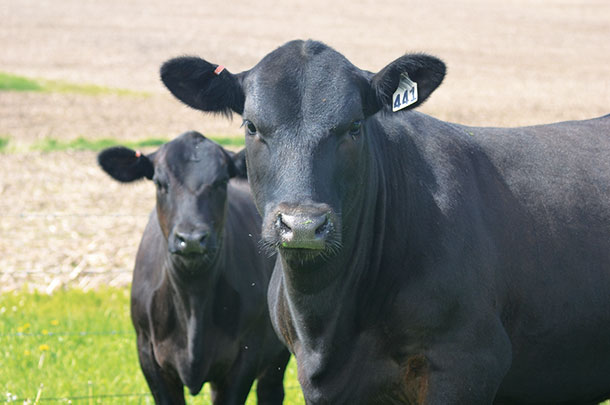The reality is: The cost is extremely high. In most herds, replacement heifers don’t pay for themselves until they’re at least 5 years old, after weaning their fourth calf. That’s why it’s so important to increase your chance for rebreeding success by implementing a high-quality nutrition program.
A heifer that isn’t nutritionally prepared at the time of calving and through the next rebreeding cycle may have reduced milk production, and her calf may have a lower weaning weight.
Additionally, the postpartum interval may be longer, causing the heifer to get bred late in the breeding season or, in some cases, not get bred at all. Research shows that heifers that are not in adequate body condition can have a 24 percent reduction in rebreeding success.
In the majority of the herds we see today, producers would like to improve their rate of success in rebreeding first-calf heifers. With a high-quality nutrition program delivered at strategic times, we can substantially improve the rate of success at an economical cost.
Developing a strategy
The future success of the herd is on the line, and there are some well-defined targets for getting replacement heifers on the path to success.
The first target includes getting heifer calves weaned successfully, with minimal stress and health issues, and getting started quickly on a high-quality weaning feed.
The second target comes at breeding time. At around 14 to 15 months old, heifers should weigh between 55 and 65 percent of mature weight. We recommend aiming on the upper end, between 60 and 65 percent of mature weight.

To meet those percentages, heifers will need to be growing at a rate of 1.25 to 1.5 pounds per day from the time they are weaned up until first breeding. A high-energy feed that uses intake control properties can work with a producer’s forages to provide a predictable intake that delivers targeted gains. We also recommend having a quality mineral available at all times.
The amount of feed needed will depend on the quality of the forage, the weight gain desired and the weather; however, spring-born heifers that get through the winter on stockpiled or harvested forage commonly need between 4 and 8 pounds of supplemental feed to deliver 1.25 or 1.5 average daily gain.
Monitoring targets, shifting strategies
We should absolutely be body condition scoring heifers, especially as we’re trying to get them bred and calve them out.
At the time of first breeding, heifers should be 60 to 65 percent of mature weight. At the time of calving, heifers should weigh 85 percent of mature weight at a 6 to 6.5 body condition score. Having condition scores in that range at calving, along with a nutrition program designed to maintain condition into the breeding season, can improve the success rate of rebreeding heifers on time.
Once a heifer calves, her energy requirements are increased by 30 percent by lactation. We can’t forget about that heifer after calving. Nutrient requirements steadily increase during the last trimester of pregnancy and through the first three months of lactation.
Producers can implement a variety of strategies to further increase heifer success and longevity in the herd.
We recommend separating young cows away from the mature cow herd to meet their higher energy requirements and improve the chance of getting them rebred.
Additionally, first-calf heifers typically have a longer postpartum interval. To manage this, heifers can be bred the first time a month ahead of the mature cow herd. This strategy gives the heifers an extra 20 to 30 days to come back into estrus and stay on schedule (for their second calf) with the mature cow herd.
We also recommend early weaning of calves from young cows.
Early weaning in advance of the mature cow herd is a recommended strategy, especially if the heifers were bred to calve before the cows.
Early weaning will reduce energy requirements and allow the young cow to regain body condition going into the winter. Maintaining body condition can help a young cow stay on schedule for subsequent calving and breeding seasons.
Profitably expanding the numbers in a cow herd, or even maintaining existing herd size, is dependent on the reproductive success rate of young cows in the herd. Success at first breeding and during subsequent breeding seasons of the young cows that often carry the most promising genetics is dependent upon quality nutrition. ![]()
N.T. Cosby is a senior consulting nutritionist with Purina Animal Nutrition. For more information on heifer nutrition, visit Purina Mills or Email N.T. Cosby.
References omitted due to space but are available upon request. Click here to email an editor.
PHOTO 1: At around 14 to 15 months old, heifers should weigh between 55 and 65 percent of mature weight.
PHOTO 2: Many producers strive to improve their rate of success in rebreeding first-calf heifers. A high-quality nutrition program delivered at strategic times can substantially improve success at an economical cost. Photos provided by Purina Animal Nutrition.








